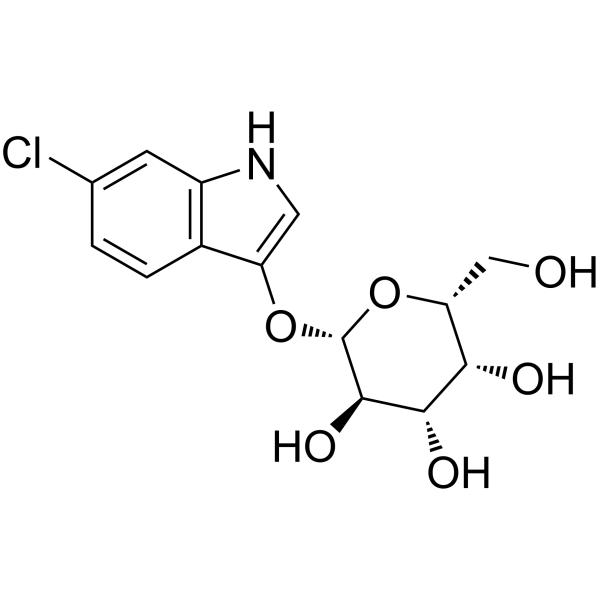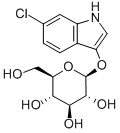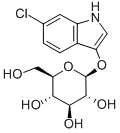6-氯-3-吲哚-β-D-半乳糖皮蒽(约含13%乙酸乙酯)[用于生化研究] ,6-Chloro-3-indolyl-ß-D-galactopyranoside
产品编号:SIGMA-RES1364C| CAS NO:138182-21-5| 分子式:C14H16ClNO6| 分子量:329.7329
玫瑰-β-D-Gal是一种荧光染料,也是一种β-半乳糖苷酶底物。玫瑰-β-D-Gal在反应后产生粉红色/洋红色,并已用于检测β-Gal活性。
本网站销售的所有产品仅用于工业应用或者科学研究等非医疗目的,不可用于人类或动物的临床诊断或者治疗,非药用,非食用,
| 产品名称 | 6-氯-3-吲哚-β-D-半乳糖皮蒽(约含13%乙酸乙酯)[用于生化研究] |
|---|---|
| 英文名称 | 6-Chloro-3-indolyl-ß-D-galactopyranoside |
| CAS编号 | 138182-21-5 |
| 产品描述 | 玫瑰-β-D-Gal是一种荧光染料,也是一种β-半乳糖苷酶底物。玫瑰-β-D-Gal在反应后产生粉红色/洋红色,并已用于检测β-Gal活性。 |
| 产品沸点 | 630.2±55.0 °C at 760 mmHg |
| 产品密度 | 1.6±0.1 g/cm3 |
| 产品闪点 | 335.0±31.5 °C |
| 精确质量 | 329.066620 |
| PSA | 115.17000 |
| LogP | -0.15 |
| 外观性状 | 固体;White to Light yellow powder to crystal |
| 蒸气压 | 0.0±1.9 mmHg at 25°C |
| 折射率 | 1.717 |
| 体外研究 | 指南(以下是我们推荐的方案。该方案仅提供指南,应根据您的具体需要进行修改)。组织免疫染色:1.在二甲基亚砜(DMSO)中制备25 mg/mL Rose-β-D-Gal储备溶液,并储存在-20°C下。保护储备溶液免受光照是至关重要的。2.准备玫瑰-β-D-Gal染色用冲洗缓冲液:0.1%脱氧胆酸钠,0.2%IGEPAL CA-630,2 mM MgCl2,置于0.1 M磷酸钠缓冲液(pH 7.3)中。通过与158mL 1M NaH2PO4、342mL 1M Na2HPO4和500mL水混合,制备1000mL 0.5M磷酸钠缓冲液(pH 7.3)。3.为新鲜玫瑰-β-D-Gal制备底物溶液,在冲洗缓冲液中含有1 mg/mL玫瑰-β-D-Gal、5 mM铁氰化钾和5 mM亚铁氰化钠。4.在PBS中对冷冻组织切片进行复水:用PBS快速冲洗两次,用冲洗缓冲液冲洗10分钟3次。5.暴露于β-半乳糖苷酶底物Rose-β-D-Gal:在37℃下染色,需要多长时间才能看到染色,长达一整夜,在显色过程中保持遮盖和黑暗。用PBS清洗5分钟两次。6.将组织固定在4%PFA中,除非打算继续原位杂交,并继续执行步骤4。注意:Rose-β-D-Gal在醇或有机溶剂中不太稳定,因此必须使用水基复染剂,如Gill’s苏木精,并用水性贴装剂盖住滑动。 |
| 稳定性 | 避免强氧化剂 |
| 储存条件 | 密封、在2 ºC -8 ºC下保存 |
相关文档
化学品安全说明书(MSDS)
下载MSDS质检证书(COA)
相关产品
| 危害码 (欧洲) | Xi |
|---|---|
| 风险声明 (欧洲) | 36/37/38 |
| 安全声明 (欧洲) | S24/25-S36-S26 |
| WGK德国 | 3 |
|
6-Chloro-3-indolyl β-D-Galactopyranoside [for
Revision number: 5
Biochemical Research] SAFETY DATA SHEET Section1. IDENTIFICATION 6-Chloro-3-indolyl β-D-Galactopyranoside [for Biochemical Research] Product name: Revision number:5 Section2. HAZARDS IDENTIFICATION GHS classification Not classified PHYSICAL HAZARDS HEALTH HAZARDSNot classified Not classified ENVIRONMENTAL HAZARDS GHS label elements, including precautionary statements None Pictograms or hazard symbols Signal wordNo signal word None Hazard statements Precautionary statements:None Section3. COMPOSITION/INFORMATION ON INGREDIENTS Substance/mixture:Substance Components:6-Chloro-3-indolyl β-D-Galactopyranoside [for Biochemical Research] Percent:>98.0%(LC) CAS Number:138182-21-5 Synonyms:Salmon-Gal , Rose-Gal C14H16ClNO6 Chemical Formula: Section4. FIRST AID MEASURES Inhalation:Remove victim to fresh air and keep at rest in a position comfortable for breathing. Get medical advice/attention if you feel unwell. Skin contact:Remove/Take off immediately all contaminated clothing. Rinse skin with water/shower. If skin irritation or rash occurs: Get medical advice/attention. Eye contact:Rinse cautiously with water for several minutes. Remove contact lenses, if present and easy to do. Continue rinsing. If eye irritation persists: Get medical advice/attention. Ingestion:Get medical advice/attention if you feel unwell. Rinse mouth. A rescuer should wear personal protective equipment, such as rubber gloves and air- Protection of first-aiders: tight goggles. Section5. FIRE-FIGHTING MEASURES Suitable extinguishingDry chemical, foam, water spray, carbon dioxide. media: Specific hazards arising Take care as it may decompose upon combustion or in high temperatures to from the chemical:generate poisonous fume. Biochemical Research] Section5. FIRE-FIGHTING MEASURES Precautions for firefighters: Fire-extinguishing work is done from the windward and the suitable fire-extinguishing method according to the surrounding situation is used. Uninvolved persons should evacuate to a safe place. In case of fire in the surroundings: Remove movable containers if safe to do so. When extinguishing fire, be sure to wear personal protective equipment. Special protective equipment for firefighters: Section6. ACCIDENTAL RELEASE MEASURES Personal precautions,Use personal protective equipment. Keep people away from and upwind of spill/leak. protective equipment and Entry to non-involved personnel should be controlled around the leakage area by emergency procedures: roping off, etc. Environmental precautions: Prevent product from entering drains. Methods and materials for Sweep dust to collect it into an airtight container, taking care not to disperse it. containment and cleaning Adhered or collected material should be promptly disposed of, in accordance with up: appropriate laws and regulations. Section7. HANDLING AND STORAGE Precautions for safe handling Technical measures:Handling is performed in a well ventilated place. Wear suitable protective equipment. Prevent dispersion of dust. Wash hands and face thoroughly after handling. Use a local exhaust if dust or aerosol will be generated. Advice on safe handling: Avoid contact with skin, eyes and clothing. Conditions for safe storage, including any incompatibilities Storage conditions:Keep container tightly closed. Store in a freezer. Store under inert gas. Store away from incompatible materials such as oxidizing agents. Heat-sensitive, Light-sensitive, Air-sensitive Packaging material:Comply with laws. Section8. EXPOSURE CONTROLS / PERSONAL PROTECTION Engineering controls:Install a closed system or local exhaust as possible so that workers should not be exposed directly. Also install safety shower and eye bath. Personal protective equipment Respiratory protection: Dust respirator. Follow local and national regulations. Hand protection:Protective gloves. Eye protection:Safety glasses. A face-shield, if the situation requires. Skin and body protection: Protective clothing. Protective boots, if the situation requires. Section9. PHYSICAL AND CHEMICAL PROPERTIES Solid Physical state (20°C): Form:Crystal- Powder Colour:White - Slightly pale yellow Odour:No data available pH: No data available Melting point/freezing point:No data available Boiling point/range:No data available No data available Flash point: Flammability or explosive limits: Lower:No data available No data available Upper: Relative density:No data available Solubility(ies): [Water]No data available [Other solvents]No data available Biochemical Research] Section10. STABILITY AND REACTIVITY Chemical stability:Stable under proper conditions. Possibility of hazardous No special reactivity has been reported. reactions: Incompatible materials: Oxidizing agents Hazardous decomposition Carbon monoxide, Carbon dioxide, Nitrogen oxides (NOx), Hydrogen chloride products: Section11. TOXICOLOGICAL INFORMATION Acute Toxicity:No data available Skin corrosion/irritation: No data available Serious eyeNo data available damage/irritation: Germ cell mutagenicity: No data available Carcinogenicity: IARC =No data available NTP =No data available Reproductive toxicity:No data available Section12. ECOLOGICAL INFORMATION Ecotoxicity: No data available Fish: Crustacea:No data available No data available Algae: Persistence / degradability: No data available No data available Bioaccumulative potential(BCF): Mobility in soil Log Pow:No data available No data available Soil adsorption (Koc): Henry's LawNo data available constant(PaM3/mol): Section13. DISPOSAL CONSIDERATIONS Recycle to process, if possible. Consult your local regional authorities. You may be able to dissolve or mix material with a combustible solvent and burn in a chemical incinerator equipped with an afterburner and scrubber system. Observe all federal, state and local regulations when disposing of the substance. Section14. TRANSPORT INFORMATION Hazards Class:Does not correspond to the classification standard of the United Nations Not listed UN-No: Section15. REGULATORY INFORMATION Safe management ordinance of dangerous chemical product (State Council announces on January 26, 2002 and revised on February 16,2011): Safe use and production, the storage of a dangerous chemical, transport, loading and unloading were prescribed. Biochemical Research] SECTION 16 - ADDITIONAL INFORMATION N/A |









 浙公网安备 33010802013016号
浙公网安备 33010802013016号